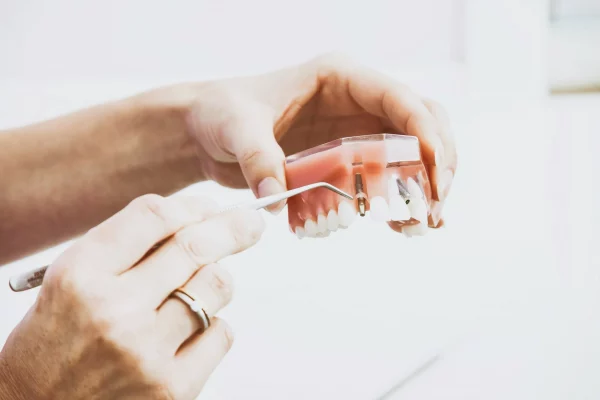Dental implants have emerged as the preferred modality for addressing tooth loss, widely regarded as the standard of care among both clinicians and patients. Unlike removable dentures, dental implants offer a fixed, aesthetically harmonious, and functional replacement for missing teeth. This approach not only restores the appearance of the dentition but also contributes to the maintenance of oral health and overall quality of life.
At G&P Dental, the implantology team adopts a patient-centered methodology, customizing treatment protocols to fit individual anatomical and clinical circumstances. This ensures that patients receive outcomes tailored to their unique needs, with the overarching aim of restoring oral function, confidence, and well-being.
This article will examine the rationale behind the widespread endorsement of dental implants, detail the procedural workflow, compare the advantages of implants relative to alternative prosthetic options, and outline the typical patient experience during implant therapy.
What Are Dental Implants?
Dental implants, essentially, represent the current pinnacle of tooth replacement technology. In clinical terms, they’re small titanium fixtures inserted directly into the jawbone, where they function as artificial roots. Through a biological process called osseointegration, the jawbone integrates with these implants, creating a sturdy and lasting support for prosthetic teeth, whether that’s a single crown, a bridge, or even a full denture.
This direct integration with the jaw not only enhances stability but also helps preserve bone density, effectively mimicking the natural stimulation provided by real tooth roots. Unlike removable dentures, which rest on the gums and can move while eating or speaking, implants remain securely anchored. Furthermore, while dental bridges may require the reduction of adjacent healthy teeth for support, implants are self-sufficient and do not compromise surrounding structures.
Because dental implants closely replicate both the form and function of natural teeth, they are widely regarded as the gold standard for tooth replacement. They facilitate efficient chewing, clear speech, and restore a patient’s smile and confidence—often to the point where the difference from natural teeth is virtually indistinguishable.
Components of a Dental Implant
A comprehensive understanding of dental implant components can significantly enhance patient confidence regarding the procedure and outcomes. Broadly, a dental implant comprises three integral elements:
Implant Fixture
This component, sometimes referred to as the implant post or screw, is a small, biocompatible titanium cylinder surgically inserted into the patient’s jawbone. The fixture acts as an artificial tooth root, affording structural stability and long-term support for the prosthesis. Through a biological process known as osseointegration, the implant fixture gradually bonds with the surrounding bone tissue, thereby establishing a robust foundation for subsequent restorative phases.
Abutment
The abutment serves as a connector, linking the implant fixture (situated beneath the gum line) with the restorative element (above the gum line). Typically fabricated from materials such as titanium, zirconia, or stainless steel, the abutment is either screwed or cemented onto the healed implant fixture. It projects slightly above the gum margin, providing a secure platform for the placement of a crown, bridge, or denture.
Dental Crown
The crown represents the visible, functional aspect of the dental implant. Custom-designed from durable materials such as porcelain or ceramic, it is meticulously shaped and shaded to harmonize with the patient’s natural dentition. Once affixed to the abutment, the crown restores the patient’s abilities to chew, speak, and smile confidently.
In summary, these three components function synergistically to replicate the appearance and biomechanics of a natural tooth, thereby facilitating both aesthetic and functional oral rehabilitation.
Why Choose Dental Implants Over Other Tooth Replacement Options?

When considering options for tooth replacement, patients typically encounter three primary solutions: bridges, dentures, and dental implants. Each method offers its own advantages, yet there are significant differences in terms of longevity, comfort, and functional outcome. Dental implants, in particular, have emerged as the preferred approach in contemporary restorative dentistry. They do not simply address the visible gap; rather, they reconstruct the tooth’s entire anatomical structure, from the root to the crown.
Bridges often require support from adjacent teeth, potentially compromising their long-term integrity. Dentures, meanwhile, rest atop the gums and may lack stability. In contrast, dental implants are anchored directly into the jawbone, effectively replicating the strength and resilience of natural teeth. This results in enhanced chewing efficiency, clearer speech, a more natural appearance, and improved self-assurance in everyday activities. Furthermore, implants play a crucial role in preventing jawbone deterioration, which is vital for maintaining facial structure and overall oral health. It is valuable to examine in detail the distinguishing features of dental implants and their implications for patient care.
Advantages of Dental Implants
Dental implants have emerged as the leading choice for tooth replacement in contemporary dentistry, and their advantages are well-documented.
- Longevity and Durability
With consistent oral hygiene and adherence to regular dental examinations, dental implants demonstrate exceptional longevity. Unlike traditional bridges and dentures—often requiring replacement or adjustment within a decade—implants represent a long-term solution for oral rehabilitation. - Preservation of Jawbone Integrity
Tooth loss frequently leads to progressive jawbone resorption. Dental implants mitigate this consequence by simulating the function of natural tooth roots. This process maintains bone density, preserves facial contours, and prevents the characteristic facial collapse seen in edentulous patients. - Restoration of Natural Function and Aesthetics
Dental implants closely replicate the function and appearance of natural dentition. They restore masticatory efficiency and allow patients to engage with a diverse diet without discomfort or functional limitations. Furthermore, the prosthetic crowns are meticulously crafted to harmonize with the adjacent teeth in color, form, and size. - Conservation of Adjacent Teeth
Unlike fixed bridges, which necessitate the reduction of neighboring healthy teeth, implants are self-sufficient. This approach preserves the integrity of the remaining dentition and supports optimal long-term oral health. - Enhanced Psychosocial Well-Being
By providing stable, natural-looking replacements, dental implants can significantly improve patient self-esteem and overall quality of life. They enable clear speech, confident smiling, and unrestricted eating, contributing positively to both oral and general health.
Who Is a Candidate for Dental Implants?
Dental implants are widely regarded as an effective and durable treatment for individuals with missing teeth, though candidacy is not universal. Several key factors must be considered to determine suitability for implant placement:
Presence of Missing Teeth
Candidates typically present with one or more missing teeth, whether resulting from trauma, dental decay, periodontal disease, or other factors. Dental implants offer a reliable means of restoring both function and esthetics in such cases.
Satisfactory General Health
Because implant placement is a surgical procedure, optimal overall health is important. Uncontrolled systemic conditions—such as unmanaged diabetes or significant immunodeficiency—may necessitate further medical evaluation prior to proceeding with treatment.
Adequate Jawbone Volume and Quality
A sufficient quantity and quality of alveolar bone are essential for successful osseointegration of the implant. In instances where bone loss has occurred, pre-implant bone augmentation procedures may be indicated to establish a stable foundation.
Non-Smoking Status or Willingness to Abstain
Smoking is known to compromise healing and is associated with a higher risk of implant failure. Ideal candidates are either non-smokers or are prepared to abstain from tobacco use, particularly throughout the post-surgical recovery period.
Commitment to Oral Hygiene and Ongoing Care
Long-term success of dental implants is contingent upon consistent oral hygiene practices and regular professional maintenance. Candidates should demonstrate a willingness to engage in daily brushing and flossing, as well as routine dental visits, to minimize complications.
In summary, while dental implants offer significant benefits, careful evaluation of these criteria is necessary to ensure optimal outcomes and patient satisfaction.
The Dental Implant Procedure: What to Expect
Getting dental implants is a multi-step process that ensures long-term success and a natural-looking result. From initial consultation to final restoration, here’s what you can expect during your dental implant journey.
Step 1 – Initial Consultation and Planning
The process begins with a thorough dental assessment, which includes diagnostic tools such as X-rays or 3D imaging to evaluate the quality of the jawbone and facilitate precise planning for implant placement. During this appointment, the dental professional reviews the patient’s health history, discusses treatment expectations, and addresses any questions or concerns.
Step 2 – Implant Placement Surgery
With appropriate anesthesia or sedation, the titanium implant is surgically inserted into the jawbone at the predetermined site. Mild swelling or discomfort may follow the procedure, but these symptoms typically resolve within several days.
Step 3 – Osseointegration and Healing
Over the subsequent three to six months, the process of osseointegration occurs, during which the implant integrates with the jawbone. This biological bonding creates a stable and durable foundation for the future prosthetic tooth.
Step 4 – Abutment Placement
After successful osseointegration, an abutment is attached to the implant. This intermediary component will serve as the connection point for the final prosthesis or crown.
Step 5 – Placement of the Permanent Crown
Finally, a custom-designed crown is affixed to the abutment, completing the restoration. The result is a fully functional and aesthetically pleasing artificial tooth that closely resembles a natural tooth in both appearance and performance.
Caring for Your Dental Implants
Dental implants represent a significant investment in both oral health and personal confidence, and their longevity relies heavily on diligent maintenance. To maximize the lifespan and functionality of dental implants, consistent and proper care is essential.
Key recommendations include brushing twice daily with a soft-bristle toothbrush and a non-abrasive toothpaste, which helps minimize plaque accumulation around the implant site. Daily flossing is also crucial, with particular attention paid to cleaning around the implant itself; specialized floss or interdental brushes may be especially effective in reaching and maintaining these areas.
Regular dental check-ups and professional cleanings are indispensable, as they allow for early detection of potential complications and support overall oral health. It is also advisable to avoid harmful habits such as smoking which can impede healing and increase the likelihood of implant failure and refrain from chewing on hard substances like ice or pens, as this may damage the implant crown. With appropriate care, dental implants can closely mimic the appearance, sensation, and function of natural teeth for many years.
Common Myths About Dental Implants
Despite their growing popularity, dental implants are often misunderstood. Misconceptions can make people hesitant to consider them, even when they’re the best option for restoring a healthy smile. Let’s debunk some of the most common myths surrounding dental implants and separate fact from fiction.
Myth #1 – Dental Implants Are Painful
A common concern among patients considering dental implants is the anticipated pain associated with the procedure. In reality, this anxiety is largely misplaced. Dental implant surgery is routinely performed under local anesthesia, which effectively numbs the area and minimizes discomfort during the process. Post-operative pain is typically mild and comparable to what one might experience after a routine tooth extraction. Most patients find that any residual soreness can be managed with standard over-the-counter analgesics, and symptoms generally resolve within a few days.
Myth #2 – Implants Are Too Expensive
While the initial cost of dental implants can appear substantial, it is important to recognize their value as a long-term investment in oral health. Unlike removable dentures or traditional bridges, which may require periodic replacement or adjustment, implants are designed to be a permanent solution when properly maintained. Their durability, superior functionality, and natural appearance often render them more cost-effective over time.
Myth #3 – Dental Implants Take Too Long
It is true that the dental implant process involves a healing phase that may extend over several months, as the implant integrates with the jawbone. However, patients are not left without dental function during this period. Temporary restorations are commonly provided, allowing for normal appearance and daily use while healing progresses. Upon completion of the process, patients receive a final crown that closely replicates the look and function of a natural tooth, offering a permanent and aesthetically pleasing outcome.
Frequently Asked Questions (FAQs)
1. How long do dental implants last?
Dental implants are built to last, often functioning well for many decades with proper care. Maintaining good oral hygiene and attending regular dental check-ups are essential to ensure their long-term success and health. With these habits, implants can provide a durable, reliable tooth replacement for life.
2. Is the dental implant procedure painful?
Most patients report minimal discomfort during the dental implant procedure, thanks to the use of local anesthesia or sedation. The process is typically well-tolerated, even for those with dental anxiety. After the procedure, it’s normal to experience mild swelling, bruising, or soreness around the implant site. These symptoms usually resolve within a few days and can be easily managed with over-the-counter pain relievers. With proper care, recovery is smooth and uneventful for most individuals.
3. Can dental implants be done if I have bone loss?
Absolutely! Thanks to modern advancements like bone grafting and sinus lift procedures, patients with insufficient jawbone density can still qualify for dental implants. These techniques rebuild and strengthen the bone structure, creating a solid foundation for implant placement. This means even those who previously weren’t candidates due to bone loss now have effective options to restore their smiles confidently.
4. How do dental implants compare to dentures?
Compared to dentures, dental implants provide far greater stability and functionality. Unlike dentures, implants are securely anchored in the jawbone, so they don’t slip or require adhesives. They also preserve natural speech and taste sensation, offering a more comfortable and natural-feeling solution. Overall, implants deliver superior aesthetics and a better quality of life.
5. Are dental implants suitable for everyone?
While dental implants are suitable for most healthy adults, certain medical conditions such as uncontrolled diabetes, heavy tobacco use, or significant bone loss may complicate treatment. Comprehensive dental assessments are essential to determine candidacy and to explore alternative treatment options if necessary.
Missing teeth holding you back? Dental implants are the most natural, long-lasting solution to restore your smile and confidence. Unlike dentures, implants look, feel, and function just like real teeth—so you can eat, speak, and smile without worry. At GPD Dental, we specialize in personalized implant care designed to fit your needs and lifestyle. Schedule your implant consultation today and take the first step toward a stronger, more complete smile.


